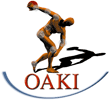Ορθοπαιδικό Αθλητιατρικό Κέντρο Ιωαννίνων
“Ένα σύγχρονο και πλήρως εξοπλισμένο εργαστήριο”
ACL reconstructed patients with a BPTB graft present an impaired vastus lateralis neuromuscular response during high intensity running.
J Sci Med Sport. 2010 Mar 11. [Epub ahead of print]PMID: 20227341
The purpose of the present study was to investigate whether the electromyographic response of the vastus lateralis (VL) muscle in the anterior cruciate ligament (ACL) reconstructed leg is similar to that of the intact contralateral leg and healthy controls, during moderate and high intensity running. Fourteen bone-patellar tendon-bone (BPTB) ACL reconstructed amateur soccer players and fourteen healthy control amateur soccer players volunteered to participate in the study. Electromyographic (EMG) traces from the vastus lateralis (VL) muscle were collected bilaterally, as athletes ran on a treadmill for 10min on separate occasions, at moderate and high intensity. The dependent variable examined was the EMG amplitude during stance. During the moderate intensity running, EMG amplitude of the VL did not increase with time for any of the tested legs. During the high intensity running, the EMG amplitude of the VL increased significantly with time for the intact (F=6.747, p=0.001) and the control leg (F=4.258, p=0.008), but remained unchanged for the ACL reconstructed leg. During moderate intensity running, there was no difference in the neuromuscular response of the VL in the reconstructed leg compared to the intact and control leg. High intensity running resulted in an impaired neuromuscular response of the VL in the reconstructed leg compared to the intact and control leg. It seems that potential impairments of the neuromuscular response after ACL reconstruction should be tested under high rather than moderate intensity efforts. Copyright © 2010. Published by Elsevier Ltd.


